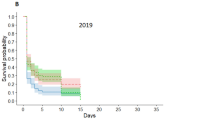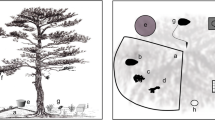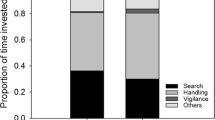Abstract
Individual variation in seed size and seed production is high in many plant species. How does this variation affect seed-dispersing animals and, in turn, the fitness of individual plants? In this study, we first surveyed intraspecific variation in seed mass and production in a population of a Chinese white pine, Pinus armandii. For 134 target trees investigated in 2012, there was very high variation in seed size, with mean seed mass varying among trees almost tenfold, from 0.038 to 0.361 g. Furthermore, 30 of the 134 trees produced seeds 2 years later, and for these individuals there was a correlation in seed mass of 0.59 between years, implying consistent differences among individuals. For a subset of 67 trees, we monitored the foraging preferences of scatter-hoarding rodents on a total of 15,301 seeds: 8380 were ignored, 3184 were eaten in situ, 2651 were eaten after being cached, and 395 were successfully dispersed (cached and left intact). At the scale of individual seeds, seed mass affected almost every decision that rodents made to eat, remove, and cache individual seeds. At the level of individual trees, larger seeds had increased probabilities of both predation and successful dispersal: the effects of mean seed size on costs (predation) and benefits (caching) balanced out. Thus, despite seed size affecting rodent decisions, variation among trees in dispersal success associated with mean seed size was small once seeds were harvested. This might explain, at least in part, the maintenance of high variation in mean seed mass among tree individuals.





Similar content being viewed by others
References
Chen F, Chen J (2011) Dispersal syndrome differentiation of Pinus armandii in Southwest China: key elements of a potential selection mosaic. Acta Oecol 37:587–593
Clark JS, Lewis M, Horvath L (2001) Invasion by extremes: population spread with variation in dispersal and reproduction. Am Nat 157:537–554
Connell JH (1971) On the role of natural enemies in preventing competitive exclusion in some marine animals and in rain forest trees. In: den Boer PJ, Gradwell GR (eds) Dynamics of populations. Centre for Agricultural Publications and Documentation, Wageningen, pp 298–310
Gomez JM (2004) Bigger is not always better: conflicting selective pressures on seed size in Quercus ilex. Evolution 58:71–80
Gross KL (1984) Effects of seed size and growth form on seedling establishment of 6 monocarpic perennial plants. J Ecol 72:369–387
Herrera CM (2002) Seed dispersal by vertebrates. In: Herrera CM, Pellmyr O (eds) Plant–animal interactions: an evolutionary approach. Blackwell, Oxford, pp 185–210
Herrera CM, Jovani R (2010) Lognormal distribution of individual lifetime fecundity: insights from a 23-year study. Ecology 91:422–430
Herrera CM, Jordano P, Lopez-Soria L, Amat JA (1994) Recruitment of a mast-fruiting, bird-dispersed tree: bridging fruigivore activity and seedling establishment. Ecol Monogr 64:315–344
House C, Roth C, Hunt J, Kover PX (2010) Paternal effects in Arabidopsis indicate that offspring can influence their own size. Proc R Soc B Biol Sci 277:2885–2893
Howe HF, Smallwood J (1982) Ecology of seed dispersal. Annu Rev Ecol Syst 13:201–228
Jacquemyn H, Brys R, Hermy M (2001) Within and between plant variation in seed number, seed mass and germinability of Primula elatior: effect of population size. Plant Biol 3:561–568
Jakobsson A, Eriksson O (2000) A comparative study of seed number, seed size, seedling size and recruitment in grassland plants. Oikos 88:494–502
Jansen PA, Bongers F, Hemerik L (2004) Seed mass and mast seeding enhance dispersal by a neotropical scatter-hoarding rodent. Ecol Monogr 74:569–589
Janzen DH (1970) Herbivores and the number of tree species in tropical forests. Am Nat 104:501–528
Janzen DH (1971) Seed predation by animals. Annu Rev Ecol Syst 2:465–492
Jordano P (1995) Frugivore-mediated selection on fruit and seed size: birds and St. Lucie’s cherry, Prunus mahaleb. Ecology 76:2627–2639
Jordano P (2000) Fruits and frugivory. In: Fenner M (ed) Seeds: the ecology of regeneration in plant communities, 2nd edn. CAB International, Wallingford, pp 125–165
Klinger R, Rejmanek M (2010) A strong conditional mutualism limits and enhances seed dispersal and germination of a tropical palm. Oecologia 162:951–963
Koenig WD, Knops JMH, Carmen WJ, Sage RD (2009) No trade-off between seed size and number in the valley oak Quercus lobata. Am Nat 173:682–688
Kosinski I (2010) Long-term variation in seed mass and seed production in populations of Paris quadrifolia. Plant Biol 12:206–214
Levin SA, Muller-Landau HC, Nathan R, Chave J (2003) The ecology and evolution of seed dispersal: a theoretical perspective. Annu Rev Ecol Evol Syst 34:575–604
Lichti NI, Steele MA, Swihart RK (2015) Seed fate and decision-making processes in scatter-hoarding rodents. Biol Rev. doi:10.1111/brv.12240
Martinez I, Garcia D, Obeso JR (2007) Allometric allocation in fruit and seed packaging conditions the conflict among selective pressures on seed size. Evol Ecol 21:517–533
Moore JE, McEuen AB, Swihart RK, Contreras TA, Steele MA (2007) Determinants of seed removal distance by scatter-hoarding rodents in deciduous forests. Ecology 88:2529–2540
Moran EV, Clark JS (2012) Causes and consequences of unequal seedling production in forest trees: a case study in red oaks. Ecology 93:1082–1094
Parciak W (2002) Environmental variation in seed number, size, and dispersal of a fleshy-fruited plant. Ecology 83:780–793
Perea R, Gonzalez R, Miguel AS, Gil L (2011) Moonlight and shelter cause differential seed selection and removal by rodents. Anim Behav 82:717–723
Roach DA, Wulff RD (1987) Maternal effects in plants. Annu Rev Ecol Syst 18:209–235
Sgro CM, Hoffmann AA (2004) Genetic correlations, tradeoffs and environmental variation. Heredity 93:241–248
Shimada T, Takahashi A, Shibata M, Yagihash T (2015) Effects of within-plant variability in seed weight and tannin content on foraging behavior of seed consumers. Funct Ecol 29:1513–1521
Smith CC, Fretwell S (1974) The optimal balance between size and number of offspring. Am Nat 108:499–506
Sork VL, Bramble J, Sexton O (1993) Ecology of mast-fruiting in 3 species of North American deciduous oaks. Ecology 74:528–541
Stanton ML (1984) Seed variation in wild radish—effect of seed size on components of seedling and adult fitness. Ecology 65:1105–1112
Susko DJ, Lovett-Doust L (2000) Patterns of seed mass variation and their effects on seedling traits in Alliaria petiolata (Brassicaceae). Am J Bot 87:56–66
Takahashi A, Shibata M, Shimada T (2011) Variation in seed production schedule among individual trees of a deciduous oak species Quercus serrata: its relation to seed characteristics. Plant Ecol 212:1527–1535
Theimer TC (2005) Rodent scatterhoarders as conditional mutualists. In: Forget PM, Lambert J, Hulme P, Vander Wall SB (eds) Seed fate. CAB International, Wallingford, pp 283–296
Thompson JN (1984) Variation among individual seed masses in Lomatium grayi (Umbelliferae) under controlled conditions—magnitude and partitioning of the variance. Ecology 65:626–631
Vander Wall SB (2002) Masting in animal-dispersed pines facilitates seed dispersal. Ecology 83:3508–3516
Vander Wall SB (2003) Effects of seed size of wind-dispersed pines (Pinus) on secondary seed dispersal and the caching behavior of rodents. Oikos 100:25–34
Vander Wall SB (2010) How plants manipulate the scatter-hoarding behaviour of seed-dispersing animals. Philos Trans R Soc B 365:989–997
Venable DL (1992) Size-number trade-offs and the variation of seed size with plant resource status. Am Nat 140:287–304
Wang B, Chen J (2009) Seed size, more than nutrient or tannin content, affects seed caching behavior of a common genus of Old World rodents. Ecology 90:3023–3032
Wang B, Chen J (2011) Scatter-hoarding rodents prefer slightly astringent food. PLoS ONE 6:e26424
Wang B, Yang XL (2014) Teasing apart the effects of seed size and energy content on rodent scatter-hoarding behavior. PLoS ONE 9:e111389
Wang B, Wang G, Chen J (2012) Scatter-hoarding rodents use different foraging strategies for seeds from different plant species. Plant Ecol 213:1329–1336
Wang B, Ye CX, Cannon CH, Chen J (2013) Dissecting the decision making process of scatter-hoarding rodents. Oikos 122:1027–1034
Wang B, Chen J, Corlett RT (2014) Factors influencing repeated seed movements by scatter-hoarding rodents in an alpine forest. Sci Rep 4:4786
Wolfe LM (1995) The genetics and ecology of seed size variation in a biennial plant, Hydrophyllum appendiculatum (Hydrophyllaceae). Oecologia 101:343–352
Wrobel A, Zwolak R (2013) The choice of seed tracking method influenced fate of beech seeds dispersed by rodents. Plan Ecol 214:471–475
Wulff RD (1986) Seed size variation in Desmodium paniculatum I. factors affecting seed size. J Ecol 74:87–97
Xiao ZS, Zhang ZB, Wang YS (2005) The effects of seed abundance on seed predation and dispersal by rodents in Castanopsis fargesii (Fagaceous). Plant Ecol 177:249–257
Xiao ZS, Wang YS, Harris M, Zhang ZB (2006a) Spatial and temporal variation of seed predation and removal of sympatric large-seeded species in relation to innate seed traits in a subtropical forest, Southwest China. For Ecol Manag 222:46–54
Xiao ZS, Jansen PA, Zhang ZB (2006b) Using seed-tagging methods for assessing postdispersal seed fate in rodent-dispersed trees. For Ecol Manag 223:18–23
Xiao ZS, Zhang ZB, Krebs CJ (2013) Long-term seed survival and dispersal dynamics in a rodent-dispersed tree: testing the predator satiation hypothesis and the predator dispersal hypothesis. J Ecol 101:1256–1264
Xiao ZS, Zhang ZB, Krebs CJ (2015) Seed size and number make contrasting predictions on seed survival and dispersal dynamics: a case study from oil tea Camellia oleifera. For Ecol Manag 343:1–8
Yi XF, Xiao ZS, Zhang ZB (2008) Seed dispersal of Korean pine Pinus koraiensis labeled by two different tags in a northern temperate forest, northeast China. Ecol Res 23:379–394
Yi XF, Yang Y, Zhang ZB (2011) Intra-and inter-specific effects of mast seeding on seed fates of two sympatric Corylus species. Plant Ecol 212:785–793
Zas R, Sampedro L (2015) Heritability of seed weight in Maritime pine, a relevant trait in the transmission of environmental maternal effects. Heredity 114:116–124
Acknowledgements
We thank Xiaolan Yang, Yuanrong Zhang and Shituan Luo for the help with the field data collection. This study was funded by the National Natural Science Foundation of China (31470494, 31100315) and the Youth Innovation Promotion Association of Chinese Academy of Sciences (2012287).
Author contribution statement
BW conceived, designed and performed the experiments. BW and ARI analysed the data and wrote the manuscript.
Author information
Authors and Affiliations
Corresponding author
Additional information
Communicated by Caroline Müller.
Electronic supplementary material
Below is the link to the electronic supplementary material.
Rights and permissions
About this article
Cite this article
Wang, B., Ives, A.R. Tree-to-tree variation in seed size and its consequences for seed dispersal versus predation by rodents. Oecologia 183, 751–762 (2017). https://doi.org/10.1007/s00442-016-3793-0
Received:
Accepted:
Published:
Issue Date:
DOI: https://doi.org/10.1007/s00442-016-3793-0




